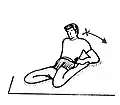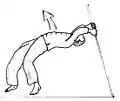
Bando yoga or Burmese yoga is a form of yoga from Myanmar usually taught alongside bando. It is probably based on the internal training of Indian martial arts and is often referred to as peasant or slave yoga. It was for the common man and also used by ancient warriors of northern Burma to maintain health and protect from illness and disease. Today it is practiced by ethnic Burmese in parts of Southeast Asia, India.[1]
Bando really spread in Burma when Japanese invaded the country in 1942.[2] It is part of a collection of martial arts called Thaing.[3]
The discipline includes the fighting and defensive behaviors of animals such as the cobra, python, viper, tiger, leopard, monkey, bull, boar and scorpion.[4]
Bando yoga is used for three main purposes. These are for maintaining overall health, resisting illness and disease, and restoring or recovering from illness and injury.[5] It is not a yoga system for enlightenment but for developing and maintaining efficient functionality in our everyday life, whether it be as a worker/laborer, monk or warrior.
There are three systems of Burmese yoga:[6] [7][8]
- dhanda yoga (decreased flexibility by using the staff)
- lonji yoga (Development of flexibility by using cloth or rope)
- letha yoga (Partner-assisted improvement of circulation and stimulation of joints)
 Leg stretch
Leg stretch Leg Stretch
Leg Stretch Stretch of Dhanda yoga
Stretch of Dhanda yoga Stretch of Longyi yoga
Stretch of Longyi yoga
See also
References
- ↑ "Myanmar Martial Arts". www.myanmars.net.
- ↑ "Burmese Martial Arts". www.combatbando.com.
- ↑ "Bando: the styles of Burmese Martial Arts". www.fightland.vice.com. 2 December 2014.
- ↑ "Bando Black belt". www.blackbeltmag.com.
- ↑ "Yoga, Meditation Tour in Myanmar". www.silkroadgroup.com.
- ↑ "Yoga System". www.americanbandoassociation.com. Archived from the original on 2015-04-02. Retrieved 2015-04-13.
- ↑ List of Top Yoga Centres in Delhi
- ↑ Yogayoga, 18 August 2023